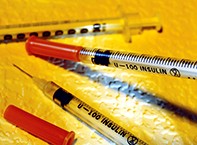Hyperglycaemia in diabetes: what next?
- high blood pressure – lisinopril 20 mg, hydrochlorothiazide 12.5 mg
- high cholesterol – atorvastatin (Lipitor) 20 mg
- gastro-oesophageal reflux – omeprazole (Losec, Acimax, Maxor, Probitor) 20 mg
- cardiovascular protection – enteric coated, low dose aspirin 100 mg.
- breakfast-time 9 to 11 mmol/L
- lunchtime 7 to 9 mmol/L
- teatime 6 to 8 mmol/L
- bedtime 8 to 10 mmol/L.
Case history
Leo is 67 years old and has had type 2 diabetes for 12 years. He was a council worker and now lives frugally on the pension with his wife, Betty, aged 62. He takes gliclazide (Diamicron, Glyade, Nidem), two 80 mg tablets twice daily, and metformin, two 500 mg tablets three times daily. He also takes medication daily for his:
Leo has had panretinal laser therapy for preproliferative diabetic retinopathy and has had microalbuminuria for the past five years. He is troubled by ‘pins and needles’ in his feet, particularly at night. He has lost a few kilograms in weight since his last visit six months ago (from 87 to 84 kg) and ‘feels fine’. Leo’s blood glucose profile is as follows:
Leo’s HbA1c has increased from 8.1 to 9.3% over the past six months.

